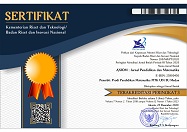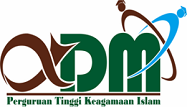The characteristics of real and pseudo-true thinking in STEM students' analytical thinking process in solving set problems
Abstract
It is essential to analyze students' cognitive development, particularly in mathematics, to determine their ability to solve problems effectively. This research focuses on analytical thinking as a critical component of students' problem-solving processes in mathematics. The subjects of this study were two students from a school in Bandung who are part of a STEM program, which incorporates additional learning approaches in science, technology, engineering, and mathematics. Through this approach, researchers aim to understand the students' analytical thinking processes and characteristics in solving given problems using qualitative methods. The instruments utilized in this study were tests and interview guidelines. The findings revealed that each student exhibited two distinct analytical thinking characteristics. The "real true thinking" character is where students can provide justification for their correct problem-solving results and navigate through the entire analytical thinking process. In contrast, the pseudo-true thinking character is unable to justify correct problem-solving and fails to complete the analytical thinking process, particularly at the differentiation stage.
Keywords
Full Text:
PDFReferences
Agustin, H.R., Darminto, B.P., & Darmono, P.B. (2018). Analisis kemampuan berpikir analitis siswa dalam menyelesaikan masalah matematika dengan metode open-ended. Ekuivalen, 38(1), 42–47. https://doi.org/10.37729/ekuivalen.v38i1.5659
Anderson, L.W., Krathwohl, D.R., Airasian, P.W., Cruishank, K.A., Mayer, R.L., Pintrich, P.L., Raths, J., & Wittrock, M.C. (2001). A taxonomy for learning, teaching, and assessing: a revision of bloom’s taxonomy of educational objectives. Addison Wesley Longman.
Art-in, S. (2014). The development of teacher training curriculum on learning management to develop students’ analytical thinking in thailand. Procedia - Social and Behavioral Sciences, 116(February 2014), 939–945. https://doi.org/10.1016/j.sbspro.2014.01.324
Carifio, J. (2015). Updating, modernizing, and testing Polya’s theory of [Mathematical] problem solving in terms of current cognitive, affective, and information processing theories of learning, emotions, and complex performances. Journal of Education and Human Development, 4(3), 105–117. https://doi.org/10.15640/jehd.v4n3a12
Cheng, M.M.H., Buntting, C., & Jones, A. (2022). Concepts and practices of stem education in asia. Springer. https://link.springer.com/book/10.1007/978-981-19-2596-2
Creswell, J.W. (2012). Qualitative inquiry & research design: choosing among five approaches (3rd ed.). New York: SAGE Publications.
Creswell, J.W. (2014). Research design: qualitative, quantitative, and mixed methods approaches. New York: SAGE Publications.
Dwidarti, U., Mampouw, H.L., & Setyadi, D. (2021). Analisis kesulitan siswa dalam menyelesaikan soal cerita pada materi statistika. Jurnal Ilmiah Pendidikan Matematika Al Qalasadi, 5(1), 72–80. https://doi.org/10.32505/qalasadi.v5i1.2366
Henriksen, D. (2014). Full steam ahead: creativity in excellent stem teaching practices. The Steam Journal, 1(2), 1–9. https://doi.org/10.5642/steam.20140102.15
Ilma, R., Hamdani, A.S., & Lailiyah, S. (2017). Profil berpikir analitis masalah aljabar siswa ditinjau dari gaya kognitif visualizer dan verbalizer. JRPM: Jurnal Review Pembelajaran Matematika, 2(1), 1–14. https://doi.org/10.15642/jrpm.2017.2.1.1-14
Karenina, A., Widoretno, S., & Prayitno, B.A. (2019). Profile of integration of problem-solving aspects with analytical-thinking aspects in human respiratory system topic. AIP Conference Proceedings, 2194, 1–6. https://doi.org/10.1063/1.5139779
Lestari, S.Z.D., & Roesdiana, L. (2022). Analisis kemampuan berpikir kritis matematis siswa smp pada materi spldv. Transformasi : Jurnal Pendidikan Matematika Dan Matematika, 6(2), 121–132. https://doi.org/10.36526/tr.v6i2.2222
Li, Y., & Schoenfeld, A.H. (2019). Problematizing teaching and learning mathematics as “ given ” in stem education. International Journal of STEM Education, 6(44), 1–13. https://doi.org/10.1186/s40594-019-0197-9
Loviasari, P.A., & Mampouw, H.L. (2022). Profil pemecahan masalah matematika pada materi himpunan ditinjau dari self Eefficacy. Mosharafa: Jurnal Pendidikan Matematika, 11(1), 73–84. https://doi.org/10.31980/mosharafa.v11i1.688
Mahyastuti, I., Dwiyana, D., & Hidayanto, E. (2021). Kemampuan berpikir analitis siswa dalam memecahkan masalah matematis. Jurnal Pendidikan Matematika Dan Sains, 8(1), 1–6. https://doi.org/10.21831/jpms.v8i1.19644
Maqruf, A., Sudirman, S., & Muksar, M. (2023). Karakteristik proses berpikir analitis siswa dalam memecahkan permasalahan himpunan. AKSIOMA: Jurnal Program Studi Pendidikan Matematika, 12(1), 563–572. https://doi.org/10.24127/ajpm.v12i1.6266
Morash, R.P. (1987). Bridge to abstract mathematics: mathematical proof and structures. New York: Random House, Inc.
Qolfathiriyus, A., Sujadi, I., & Indriati, D. (2019). Characteristic profile of analytical thinking in mathematics problem solving. Journal of Physics: Conference Series, 1157(3), 1–6. https://doi.org/10.1088/1742-6596/1157/3/032123
Rabindran, & Madanagopal, D. (2020). Piaget’s theory and stages of cognitive development- an overview. Scholars Journal of Applied Medical Sciences, 8(9), 2152–2157. https://doi.org/10.36347/sjams.2020.v08i09.034
Roberts, A., & Diana Cantu. (2012). Applying stem instructional strategies to design and technology curriculum. https://ep.liu.se/ecp/073/013/ecp12073013.pdf
Romli, M. (2016). Profil koneksi matematis siswa perempuan sma dengan kemampuan matematika tinggi dalam menyelesaikan masalah matematika. Julnal Ilmiah Pendidikan Matematika, 1(2), 145–157. https://doi.org/10.26877/jipmat.v1i2.1241
Ruangsiri, K., Nuangpirom, P., & Akatimagool, S. (2022). Promotion of high-order analytical thinking skills using ncom simulator through steam education. ICTechEd7: 7th International Conference on Technical Education, 19–23. https://doi.org/10.1109/ICTechEd749582.2020.9101305
Shuell, T.J. (1986). Cognitive conceptions of learning. Review of Educational Research, 56(4), 411–436. https://doi.org/10.2307/1170340
Sidik, F. (2020). Actualization of the jean piaget cognitive development theory in learning. JURNAL PAJAR (Pendidikan Dan Pengajaran), 4(6), 1106–1111. https://doi.org/10.33578/pjr.v4i6.8055
Subanji, S. (2011). Teori berpikir pseudo penalaran kovariasional. Malang: UM Press.
Syavarizca, D., & Sumaji. (2021). Kajian hots (high orger thinking skill) dan kaitannya dengan berpikir analitis. EKSAKTA : Jurnal Penelitian Dan Pembelajaran MIPA, 6(1), 10–18. https://doi.org/10.31604/eksakta.v6i1.10-18
Uzzo, S.M., Graves, S.B., Shay, E., Harford, M., & Thompson, R. (2018). Pedagogical content knowledge in stem. New York: Springer.
Vinner, S. (1997). The pseudo-conceptual and the pseudo-analytical thought processes in mathematics learning. Educational Studies in Mathematics, 34, 97–129. https://doi.org/10.1023/A:1002998529016
Waskita, P.D., Wahyuni, D., & Nugroho, P.B. (2019). Proses berpikir analitis mahasiswa berkarakter charismatic leadership. Seminar Nasional Pendidikan, 219–225. https://jurnal.umj.ac.id/index
Wibawa, K.A. (2016). Karakteristik berpikir pseudo dalam pembelajaran matematika. 1–16. https://doi.org/10.13140/RG.2.1.3907.3528
Widiyastuti, E., & Jazuli, A. (2019). Deskripsi kemampuan berpikir analitik matematis mahasiswa pendidikan matematika. Proceeding of The 8th University Research Colloquium 2018: Bidang Pendidikan, Humaniora Dan Agama, 401–409. https://garuda.kemdikbud.go.id/documents/detail/3723530
Wijaya, A.P., Nusantara, T., Sudirman, & Hidayanto, E. (2023). How are students’ prior knowledge differentiate analytical thinking process in identifying the convergence of real number sequences? International Journal of Instruction, 16(1), 205–218. https://doi.org/10.29333/iji.2023.16112a
DOI: http://dx.doi.org/10.30821/axiom.v14i1.22006
Refbacks
- There are currently no refbacks.
Copyright (c) 2025

This work is licensed under a Creative Commons Attribution-ShareAlike 4.0 International License.
p-ISSN: 2087-8249 | e-ISSN: 2580-0450
Indexed by:
AXIOM : Jurnal Pendidikan dan Matematika is licensed under a Creative Commons Attribution-ShareAlike 4.0 International License.











